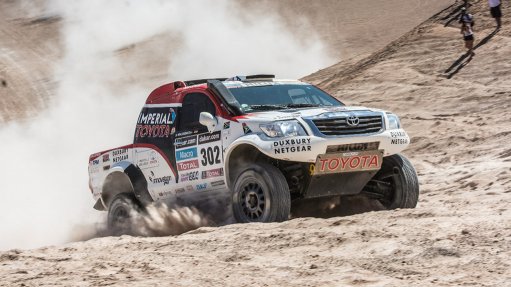
The Toyota Imperial Hilux team secured a fourth place in the 2014 Dakar Rally, held in South America, and not first, as had been aspired to when the event kicked off on January 5.
Toyota Motorsport South Africa, headed by Glyn Hall, entered two locally made Hilux bakkies in the 9 300 km event. The lead vehicle was driven by previous winner Giniel de Villiers, assisted by navigator Dirk von Zitzewitz, with Dakar rookie Leeroy Poulter behind the wheel of the second vehicle, aided by navigator Rob Howie.
Poulter and Howie finished the race on Saturday at number 33.
The 2014 Dakar Rally was won by Nani Roma, from the Mini X-raid team, which made a clean sweep of the podium.
Toyota Motorsport South Africa recorded a third place in the 2012 Dakar Rally, following it up with a second place in last year’s event. However, that almost numerically natural first place in the January 2014 rally did not happen for the Toyota Imperial South Africa team.
“We should send Glyn for mathematics lessons. We wanted 3,2,1, and he did 3,2,4,” quipped Toyota South Africa Motors (TSAM) sales and marketing senior VP Calvyn Hamman on Monday morning as the team returned to South Africa.
Speaking at the OR Tambo International Airport, Hall noted that the 2014 Dakar was “a tough event” for the team and for him personally.
“We did so much testing, we were there to win. We were so much quicker than last year . . . and then Giniel stopped due to a hydraulic problem. That’s the Dakar. One moment you are up, and then you are down.”
De Villiers said the second week of the rally went better than the first in terms of technical challenges.
“We did not have the best start possible. We had issues with the power steering that put us on the backfoot. Once we had that sorted out, we had incredible reliability from the Hilux.”
De Villiers and Von Zitzewitz also suffered 13 punctures during the race.
“We are not on the same page as the Mini team in terms of power,” added De Villiers. “We struggled to stay with Mini in the sand and the very high altitude. We need to rectify this and take the fight to Mini next year.”
Taking place over desert and mountain landscapes, the 2014 Dakar saw 500 km of racing take place at an altitude of 3 600 m, for example.
“This is not good for our engine and its small restrictor,” said De Villiers.
The Toyota Hiluxes make use of petrol engines, while the Mini team race with diesel engines.
It became more evident this year that the engine restrictions laid down for the Dakar “were not balanced between diesel and petrol cars and the buggies”, noted Hall.
“The altitude and sand showed this.
“We need a big change because this is not healthy for the sport.”
He noted that discussions on the matter would take place soon.
“Things will change next year. We just hope it changes enough.”
Hamman said Toyota would support Hall’s Dakar team again in 2015, after which it would assess the continuation of its sponsorship.
MIXED RESULTS FOR FORD
Team Ford Racing entered two South African-made Ford Rangers in the 2014 Dakar Rally.
The purpose-built bakkies were prepared by Pietermaritzburg-based Neil Woolridge Motorsport, while logistics was handled by Germany-based company, South Racing.
The lead Ford, driven by Argentine duo Lucio Alvarez and Ronnie Graue, finished the Ford Ranger’s Dakar Rally debut in 22nd position.
Their South African team-mates, Chris Visser and Japie Badenhorst, retired their similar Ranger in the second stage after a heavy roll.
“With retrospect, without a doubt I know we could have done better,” said team manager Neil Woolridge.
“Our first priority was to finish, secondly to get into the top ten and even to get into the top five would be like winning. Apart from the problems we had on the first couple of days, the results have shown that this was attainable.
“Aside from an issue with the wheels and the engine management problems with the throttle body and variable cam timing, the Ranger has been fantastic and has performed really well. To achieve that first time out for a brand new project is superb and we can give ourselves a pat on the back.”
More than half the 147 starters failed to complete this year’s Dakar Rally, which journeyed north through Argentina, before crossing the Andes mountains and heading south along Chile’s coast.
The Hilux is produced at TSAM’s Durban plant, and the Ford Ranger at Ford Motor Company of Southern Africa’s Pretoria plant.